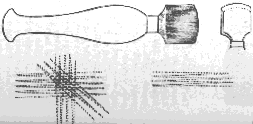William Hogarth (1697-1764) was one of the most successful of English engravers producing paintings specifically to be translated into prints. He was instrumental in obtaining parliamentary legislation to protect the artist through copyright.
By the early 1800's, the production of prints by artists from their paintings had become a very good source of income outstripping the gain from the sale of the original.
Other contemporary artists were already producing mezzotints of their work generally as a portraiture medium. Between 1807 and 1819, J M W Turner had published his famous 'Liber Studiorum' prints to advertise his abilities as a landscape artist. Turner's drawings had been partially mezzotint processed by a professional printer (Charles Turner). J M W T, in turn, progressed to producing a finer set of such prints himself.
John Constable in 1833 also produced a fine series of true mezzotints (contract printed by David Lucas) 'Various Subjects of Landscape'.
Although financially stretched, John Martin realised this source of income and arranged his own printing facilities in his 1818 move to Allsop's Buildings. Here he experimented with various processes and inking techniques.
Intaglio printing methods involve the use of a metal plate (copper, iron, steel or zinc). The plate face is grooved by engraving or etching with the required work. The grooves are filled with ink the plate then being carefully wiped. The paper is forced against the plate in a press and the ink is transferred to the paper producing a raised 'positive' image. The Mezzotint (see below) is a variation of this basic process.
In 1822, Thomas Lupton in London developed a soft steel printing plate capable of multiple reproductions with little degradation in quality compared to that of the previously used, rapidly wearing, copper plates. Martin worked with Lupton on this method realising the potential for large scale reproductions.
JM had, unsuccessfully, tried to use Charles Turner to produce some work. He was so dissatisfied with the results and delay he decided to use Lupton's process himself.
By 1823, the Mezzotint process was undertaken personally and expertly by Martin. The densely worked plate and inking technique are critical but capable of producing reasonable contrast if lacking some of the fine toning of copper.
He had particularly in mind a large print of his 'Joshua Commanding the Sun to Stand Still upon Gibeon' (see 'Other Prints') which Charles Turner, his previously contracted printer, had not completed as a copper plate. The steel mezzotint was finished in a month and dedicated to Prince Leopold.
By 1829, most of Martin's income was realised from his prints.
Mezzotint Production

The Mezzotint Grounding Rocker Tool and Formatting on a Plate
The first mezzotints were invented by a German soldier, Ludwig von Siegen in 1642. He used a 'roulette' tool. This was further developed by Prince Rupert in Frankfurt circa 1650 with his invention of the 'rocker' grounding tool. Technique was further developed in Holland by Wallerant Vaillant and others. In England, the first mezzotinter was a pupil of Prince Rupert, William Sherwin, 1669. English mezzotints became so good as to warrant the process being termed 'la manière anglaise'. John Smith was one of the English experts along with John Simon. In the 1730 - 40's, John Faber also became popular and was followed by an influx of Irish 'tinters' 'The Dublin Group' with James McArdell until around 1770. Richard Earldom then specialised in mezzotints of Old masters and reproductions of drawings of Claude Lorraine's 'Liber Veritatis' in 1777. This was to be the inspiration for Turner's 'Liber Studiorum' above.
The mezzotint technique involves the artist working from 'dark' to 'light', the reverse from normal. The metal plate is first formatted with a rake like toothed 'rocker' grounding tool as above. The tool is held at right angles to the plate and rocked as it is dragged over. This scours the plate producing burrs which retain the ink when wiped. On steel, the burring is less prone to wearing out than copper plates. The grounding is made uniformly in vertical, horizontal and diagonal passes of the tool to give a fine resolution.
In this state, inking of the plate and printing would thus produce a completely black sheet. By carefully scraping away the burrs and varying the depth, the finished plate is produced which gives the excellent shade reproduction so admired by the portrait artists. This is skilled work but the inking of the plate was even more so for fine results.
Martin was famous for his control of 'chiaroscuro', the division and distribution of light and shade, in his works and the mezzotint proved a perfect medium to demonstrate this.